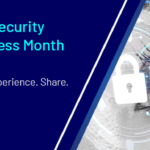Cyber Security Awareness Month: How can IT and security teams put cyber security higher on the agenda across their organization?

Cyber Security Awareness Month
Cyber security first
How can IT and security teams put cyber security higher on the agenda across their organization?
Cyber Security Awareness Month
Now in its 18th year, Cyber Security Awareness Month continues to raise awareness about the importance of cyber security across the world. The theme for Cyber Security Awareness Month 2021 is “Do Your Part. #BeCyberSmart.”
The theme empowers individuals and organizations to own their role in protecting their part of cyberspace. If everyone does their part – implementing stronger security practices, raising community awareness, educating vulnerable audiences or training employees – our interconnected world will be safer and more resilient for everyone.
Cyber security first
Week 4 is all about making security a priority for businesses, this means building security into products and processes, making cyber security training a part of employee onboarding and equip staff with the tools they need to keep the organization safe. To support this weeks’ theme we have outlined our guidance on practical ways to help make cyber security a priority across all departments in your organization.
Cyber security threats continue to grow in the Covid-19 age. On the one hand, companies are undergoing a sea change, while the threat landscape is rapidly increasing as more individuals work from home. There is increasing demand for executive teams to step up and improve their cyber security capabilities. The financial and reputational repercussions of a data breach or cyber security disaster have never been higher. According to the FBI’s newly published Internet Crime Report 2020, cybercrime cost $4 billion last year, a low estimate that nevertheless captures the enormous value lost to threat actors. Costs may be disastrous for small companies. According to Vox, 60% of small companies would be forced to close after a data breach, highlighting the high-stakes aspect of cybersecurity.
Simply put, companies cannot ignore cyber security anymore. Senior management and the Board of Directors must address the problem immediately and prioritize the security of current and future systems and technology. This must then cascade down to day-to-day company activities such as Human Resources and Marketing from the top. Not only will this safeguard businesses against cyber security threats, but it will also serve as a critical differentiator for enterprises, ensuring their bottom line and consumers are protected for years to come.
When executives use their expertise and leverage their vantage point to effectively establish standards and keep security activities aligned with the business goals. It would then be easier to provide coverage for the different areas of cyber security and risk management.
In this blog post, we outline our guidance on practical ways to help make cyber security a priority across all departments in your organization.;
Focus on risks, not vulnerabilities
It’s critical to remember that security is no longer limited to patching and safeguarding IT systems. A culture needs to be established that being cyber-aware begins at the top. With the rise in sophistication of spear phishing attacks, the board and senior leadership team is more exposed than ever. CFOs consider risk mitigation expenses concerning possible exposure, which is why CISOs must explicitly demonstrate ROI: What effect could this have on the stock price and shareholder value? What is the potential cost of a vulnerability in comparison to the cost of remediation? Attempting to protect against every potential danger may be too expensive and could even stifle company innovation and development. Collaboration is required to strike the proper balance between risk priority and effective security measures.
Identify a security saviour
In recent years, top executives have concentrated their efforts on methods to diversify their boards of directors. Along with diverse views and experiences, boards may benefit from appropriate skills such as investment management, information technology, human resources, and risk management.Additionally, there is a case to be made for appointing a cyber-risk champion to the board of directors, especially in heavily targeted sectors such as banking, retail, health care, and utilities. Having a security advocate on the board of directors will assist in keeping security front of mind. A board member with expertise in security or previous experience dealing with significant breaches may assist business focused members in making sense of quickly shifting threats.
Do not forget about internal cyber security risks
While unscrupulous bad actors from far-flung corners of the world target companies with phishing schemes, ransomware, and other cyber assaults that jeopardise operational consistency, data privacy, and financial viability, the most significant and manageable dangers are much closer to home. Employees of a business pose a major cyber security risk, since employee carelessness and human error contribute significantly to many data breaches and cyber security incidents.As a result, information technology executives need visibility into their organization’s digital environment to detect possible hazards and create appropriate solutions. Therefore, data- and intelligence-driven surveillance and identification methods are the initial steps toward comprehending the manageable threat environment and avoiding a cyber security crisis.
Constantly evaluate cyber security practices
Data protection and cyber security need continuous monitoring and awareness. Companies’ defensive measures must develop in lockstep with evolving threat trends. For instance, more than 50% of legal and compliance professionals recently recognized third-party suppliers as a major new cyber security threat during the epidemic. As a result, businesses may need to integrate third-party suppliers into their cyber security strategy to handle new threats before they become a major issue. To succeed, executives must continuously analyse internal behaviour and emerging external trends to create dynamic best practices for data security.
Establish agile management procedures
Since new vulnerabilities are continuously being discovered and attackers’ methods are constantly evolving, security programmes need agile management procedures to keep up. Organizations must manage security following best practices and with emergency preparedness and backup plans in place, just as they must manage core systems by best practices and with resilience plans in place. Just as businesses strive for continual improvement in operations, customer service, and other critical functions, the board of directors and chief financial officer should anticipate the same for security.Managing security programmes and defending against attackers will always involve a trade-off between expense and risk, but with so much at stake, security choices must be made with intelligence, strategy, and collaboration. Boards of directors and chief financial officers are critical participants in this discussion. Enterprise risk management must be built on a foundation of preparation to foster risk resilience. This is accomplished by assessing threat vectors from a business acceptability and risk profile perspective. The most effective method to safeguard assets and protect people is to lead the organization to a state of preparedness, resilience, and responsiveness. Incidents will occur due to the impossibility of avoiding every breach. However, you may commit to developing a mature, realistic, multidisciplinary, and collaborative approach to cyber security and resilience.
Summary
Businesses often fail to invest properly in cyber security until it is too late. Nevertheless, identifying and addressing this issue does not require substantially increasing the company’s cyber security budget or instituting extensive monitoring processes. Rather than that, by concentrating internally on realistic, attainable reforms, businesses may significantly enhance their security posture, enabling them to function confidently in a perilous digital environment.
How can CyberCX help?
CyberCX’s team of experts can help your organization to define and build a bespoke security programme based on your business objectives to minimise your cyber risk and prevent costly cyber-attacks.






